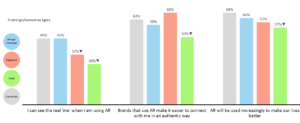Originally published by Campaign US
By Jessica Heygate | August 22, 2023
EXCLUSIVE: Research by Omnicom Media Group and Snapchat finds that AR filters and lenses are alienating diverse users by misgendering them or removing their defining features.
Augmented reality (AR) advertising is growing rapidly, yet the majority of experiences leave out diverse audiences and can be damaging to users’ self-esteem, according to a new study.
Media buying network Omnicom Media Group (OMG) and Snapchat partnered on a research study that explored the long-term implications of AR on brand building.
The study involved interviews with AR practitioners and creators; quantitative surveys with 5,000 internet users across Australia, Canada, Saudi Arabia, the U.K. and the U.S.; and a four-week measure of how brand associations changed over time with U.S. respondents.
AR is a fast-growing industry, spurred by the explosion of transformative filters offered by social apps including Instagram, Snapchat and TikTok, as well as standalone AR apps such as Pokémon Go. Upcoming mixed reality headsets from Apple and Meta are also drumming up excitement for the technology.
It is estimated that 2.9 billion users worldwide will be frequent AR users in 2023, a number that is expected to grow to 4.3 billion by 2025 — equivalent to nearly 75% of the global population, according to a 2021 Deloitte study commissioned by Snap Inc.
Correspondingly, ad spend on AR is forecasted to surpass $1 billion in the U.S. this year and grow by 57% to reach $1.6 billion by 2027, according to Statista.
OMG and Snapchat’s study found that sponsored AR experiences boost a variety of brand perceptions and lead to increased recall and purchase intent when compared to vertical video ads. It also found that AR complements video ad buys by driving incremental gains, rather than acting as a replacement.
However, brands are not testing whether their AR experiences resonate with all users, as filters and lenses often whitewash diverse users or misidentify them.
Just under half of white and African American respondents said they can “see the real me” when using AR, a statement that resonates less with LGBTQIA+ users (38% agreed), Hispanic users (37%) and Asian users (30%).
Asian users were least likely to feel that brands were using AR to connect with them “in an authentic way.”

(Source: OMG / Snap)
Non-white users specifically cited issues with their skin tones, eyes and noses being altered by lenses in a way that removes their identifying features.
In one example, an AR lens from a beauty brand that added mascara to users’ eyes transformed the eyes of Asian users to appear more Caucasian.
LGBTQIA+ users, meanwhile, find that lenses can misgender them.
The impact of social media filters and lenses on users’ body image and mental health is also an issue that is being scrutinized by governments around the world.
In a recent example, TikTok’s popular “bold glamor” filter has sparked widespread criticism for significantly alerting users’ faces in a way that exacerbates their insecurities. A July survey from beauty and hairstyle app StyleSeat found that one in five respondents said they felt more insecure after seeing themselves with the filter.
“We did some qualitative interviews and found that if you show users too much of an idealized version of themselves, that creates pressure for a lot of people in terms of how they should look and act,” said Kevin Soh, associate director of primary research at OMG.
To avoid this, Soh suggested brands should focus on “celebrating what you do have instead of highlighting things that you might not have.”
Another option is to offer more control over how transformative filters work, such as adding functionality that allows users to toggle with the intensity of the filter or select areas of their face they would like the filter to avoid, Soh said.
“Having the consumer feel as if they’re a part of the development of the brand or the product or the experience is something that hits very positive chords,” said Pamela Marsh, managing director of primary research for OMG.
The risks of AR filters are greater than other forms of advertising because of how personal they are to the user, Marsh and Soh agreed.
“You need to be a lot more responsible when you’re playing in this space,” said Marsh.
“In no other media format are you essentially the star of an ad,” added Soh.
Failing to design AR experiences that are inclusive could damage brand perceptions and lead to missed revenue opportunities.
“We know that in aggregate, all of these different individual, underserved segments are probably the future majority — not just of the population — but also of the consumer landscape. They’re sizable, they’re growing and they’re lucrative,” said Marsh.
“We know also from previous research that a lot of these segments have been craving for brands to communicate with them in ways where they feel included and understood, ” she added.
Mike Roca, executive director of OMG’s cross-cultural planning practice Elevate, said the study “underscores the importance of upstreaming diversity in the strategic process.”
“This is true for any campaign, but even more so for a format where the majority of users are also the two most diverse generations (Millennials and Gen Z), with clearly defined expectations of what they expect from brands who want a relationship with them,” Roca said.
